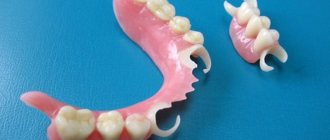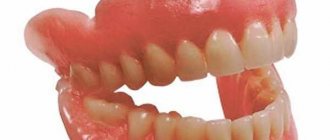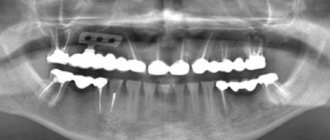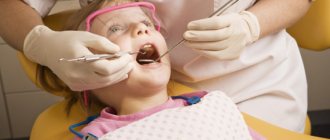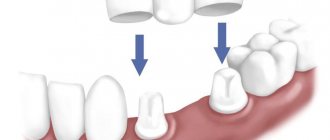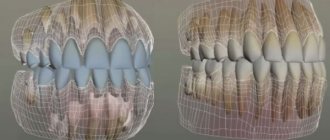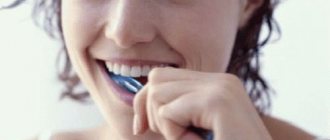Teething symptoms are of interest to many parents. After all, we are talking about an important and responsible physiological process. Every mother should know about the signs of teeth in a 4-month-old baby. A child at the age of four months cannot yet physically tell his parents that he is bothered by pain, where exactly it hurts. Therefore, during this period, parents should be as attentive as possible to the condition of their child. Despite the fact that in most cases, teething in infants begins at the age of about six months, active growth of the first units is often observed in babies at four months. Usually the middle incisors appear first. Parents should be able to distinguish signs of growth of baby teeth from pathologies in order to provide timely assistance to the baby. Our article today is devoted to the topic - signs of teeth in a 4-month-old child.
Content:
- Causes of the anomaly
- What does a “shark” smile lead to?
- When to see a doctor
- When to hesitate to see a doctor
- How is the treatment carried out?
The situation when a molar has erupted, but the milk tooth is in no hurry to leave its place, dentists call a “shark” bite. This is due to the fact that sharks also have units arranged in two rows. In humans, such an anomaly does not look aesthetically pleasing at all. Parents usually get very scared when they see a “double” smile on their child. Should I be concerned if a tooth comes out but the baby tooth does not fall out, and what could this lead to? Let's figure it out together.
Forms of caries of primary teeth in children -
As we said above, caries can occur in children as early as 1 year of life, starting from the moment the primary teeth erupt. Caries of permanent teeth also begins in children from the moment they erupt, i.e. at the age of 5-6 years. And if in preschoolers and schoolchildren the resulting carious defect can exist for quite a long time (until the transition of caries to pulpitis and periodontitis), then in children under 2-3 years of age, a rapid development of caries and its complications is usually observed. The reasons for this are the following factors:
- weak enamel mineralization,
- a very thin layer of tooth enamel,
- a very thin layer of dentin (only 1-2 mm) that separates the enamel from the pulp of the tooth.
Therefore, even from shallow carious defects, bacteria very quickly enter the pulp (the neurovascular bundle located in the center of the tooth) and first cause the development of inflammation and then the death of the pulp. Therefore, parents should pay attention not only to the appearance of already typical carious defects. The initial form of caries in children is manifested in the formation on the surface of the enamel - white chalky spots (foci of demineralization), the appearance of which precedes the occurrence of carious defects themselves.
Forms of dental caries in children:
- The initial form of caries (Fig. 5-6) - with irregular oral hygiene, microbial plaque accumulates at the necks of the teeth. Plaque bacteria produce acid, which begins to dissolve the already weakly mineralized enamel, which leads to the formation of foci of demineralization on the surface of the tooth enamel. The latter look like white chalky spots, slightly rough to the touch.
Parents often do not notice the appearance of such spots in time, because... they are hidden under a layer of soft plaque. Or the parents do not see anything serious in their appearance. If during this period there is no normalization of the child’s oral hygiene, as well as his diet, the white spots on the surface of the enamel very quickly turn into superficial carious defects.
- Superficial caries (Fig. 7) - at this stage of caries development, only the tooth enamel is affected, i.e. The carious process does not yet affect the layer of dentin located under the enamel. Superficial carious defects usually appear directly on the site of previous foci of demineralization (white chalky spots). By the way, this is clearly visible in Fig. 2.
- Middle caries (Fig. 8-9) - at this stage of development, the bottom of the carious cavity is localized already below the enamel-dentin border, i.e. located in the middle layers of dentin. If initial and superficial caries remain, as a rule, unnoticed by parents, then intermediate caries is clearly visible on the surface of the tooth. In addition, children may already experience short-term pain when eating cold or sweet foods, but young children are not able to express their feelings.
Moreover, in children under 2 years of age, tooth damage by medium caries most often tends to unlimited planar and circular distribution. Those. A carious lesion can occupy several entire tooth surfaces at once. And only after 2 years of age, the carious lesion will have its usual appearance - a limited carious cavity (saucer-shaped). - Deep caries (Fig. 10) is the next stage in the development of the carious process, but in children under 3 years of age this form of caries practically does not occur. The latter is due, among other things, to the fact that in children of this age group the thickness of dentin is only 1-2 mm, and therefore, even with a shallow carious cavity, infection of the pulp (neurovascular bundle) quickly occurs - with the subsequent development of pulpitis and periodontitis.
Causes of the anomaly
If the permanent tooth is erupting but the baby tooth has not fallen out, it can be assumed that the child is not eating enough solid food. With a deficiency of chewing load, the roots of temporary units are in no hurry to dissolve.
The diet of modern children is indeed too “gentle”, one might even say refined. It consists of products that have undergone step-by-step heat treatment. Chewing them requires almost no effort.
If parents think that children need to be given soft and thoroughly steamed food, then they are mistaken. To change teeth in a timely manner and form a correct bite, you need to eat a lot of fresh vegetables and fruits, and other foods that require careful chewing. Then the problem of preserving primary canines, incisors and molars for too long will not arise.
Another possible cause of the problem described is the presence of scars on the gums. If in the first years of life the baby has undergone dental surgery or received a serious injury, a burn to the oral cavity, scars may form on his gums. They consist of very dense connective tissue that prevents teeth from erupting.
Dangerous symptoms: what parents should know about
When a baby's teeth erupt before one year, the immune system weakens significantly. At this time, the child’s body becomes especially vulnerable, so the baby can easily catch a virus or a cold. Taking this into account, parents should be aware of the first symptoms of diseases in order to contact a pediatrician in time and begin treatment. Every mother should be able to distinguish between the symptoms when teeth erupt and when ARVI develops. Often the growth of the baby's lower incisors is accompanied by a cough. This phenomenon occurs due to the abundance of saliva in the mouth, which, flowing down the throat, provokes a cough.
If coughing becomes regular, intensifies in the evening and wheezing occurs, this is a cause for concern. In young children, a “cold” cough can last more than three days. Therefore, it is necessary to contact your pediatrician for help as soon as possible. Modern syrups quickly eliminate cough. But such drugs should only be prescribed by a pediatrician. Normally, the appearance of nasal discharge should not last more than three days.
In healthy children, when teething, nasal discharge will be clear and runny. And during infection, they acquire a yellowish tint and become thick. Normally, elevated body temperature should not be higher than 38 degrees. It usually occurs within two days. And as soon as the tooth comes out, it goes away on its own. It is quite easy to bring down the temperature during teething. But with an infectious disease, the fever can last quite a long time. The development of an intestinal infection will be indicated by the appearance of diarrhea, which lasts three or more days. Dehydration is extremely dangerous for young children, so the help of a pediatrician is necessary for such symptoms.
What does a “shark” smile lead to?
Should you be scared if a new unit comes out, but the milk unit does not fall out? This situation should alert parents. Double dentition can lead to problems with articulation and diction. Then the child will have difficulties with the correct pronunciation of sounds and words.
Also, many patients with the described anomaly have difficulty eating food - they feel uncomfortable biting off hard foods, and when chewing them, small particles often get lodged under the gum. This means that the child will get used to swallowing poorly chewed food. This leads to disturbances in the functioning of the gastrointestinal tract, including flatulence and abdominal pain.
It happens that children who have double units in several places at once begin to lose weight. This is again due to improper chewing of food. During a meal, they swallow large pieces and because of this they swallow a lot of air. Therefore, they often have the illusion of satiety - a feeling of fullness when very little has been eaten.
Among the dental complications caused by untimely change of units:
- caries;
- inflammation of the gums;
- deposition of a large amount of soft plaque.
Therefore, you should not put off visiting the dentist. The doctor will conduct an examination and decide whether to remove the extra unit.
The main reasons for the development of pathology
Currently, no scientist can give a definite answer about what causes the development of this disorder. It is customary to identify several basic theories, each of which has the right to exist, but has no evidence.
Some believe that we inherited the presence of additional teeth from distant ancestors, because they, as is known, had 6 incisors, and not 4. Since additional units usually erupt in the front part of the jaw, they are usually attributed to genetics.
Another version is the splitting of the tooth buds into two parts during the period of intrauterine development of a person. The cause may also be a malfunction in genes, as well as heredity. In any case, having more teeth than necessary gives a person a lot of trouble. In addition, this affects appearance and can cause problems with diction. Today there are several methods for eliminating this pathology.
When to see a doctor
Doctors believe that a “shark” smile can last up to two to three months, then it is necessary to take action. If the baby tooth does not fall out within the specified period, it needs to be removed. If you do not do this, the complications described above may occur.
But what’s even worse is that the child’s bite may be disrupted. The permanent unit will take the wrong position or be at the wrong angle. Then you will have to correct its position using plates or braces, and this is always difficult and time-consuming.
It is important to know! If a permanent tooth has come out, but the baby tooth has not yet fallen out, you can monitor the situation for several weeks. It is important to ensure that the child carefully maintains oral hygiene. If after two or three months nothing has changed, you need to make an appointment for your baby to see a dentist. But this recommendation is relevant only if the little patient is not bothered by anything and does not complain of toothache.
When does the first baby teeth begin to grow?
In pediatric dentistry, the norm for the appearance of the first primary incisors is between four and seven months. But it happens when teeth come out much earlier. It is very important to initially understand that doctors do not set exact dates. The timing of teething is different for all babies. Even if teeth have grown in a two-month-old baby and this process is not accompanied by any pathological processes, then this is not a reason to panic. There are cases when signs that the first teeth are coming in appear at the age of 4 months. Signs of teething appear in some children even at 3 months. Everything happens individually, so for some children the process of teeth appearing is quick and almost painless. For other babies, teething takes much longer, and the process is accompanied by symptoms such as high fever, refusal to eat, and anxiety. According to children's specialists, the first incisors should appear before the age of one year. The growth of teeth in infants is influenced by many factors:
- Heredity.
- Ecology.
- Mother's diet.
If a baby does not erupt teeth until he is one year old, the reasons for this phenomenon may be:
- Weakened children's body.
- Various diseases of the endocrine system.
- Incorrectly formulated diet.
- Rickets.
Pediatric dentists do not consider the growth of baby teeth closer to the age of one year as a pathology. Therefore, a baby’s first teeth at 4 months is the norm. Experts explain the appearance of the first teeth in a three-month-old child by saying that, perhaps, during the period of bearing the child, the expectant mother took specific vitamins and minerals. If your baby's first teeth appear before three months, you can contact a pediatric dentist to rule out signs of disruption to the endocrine system.
When to hesitate to see a doctor
If a “shark” problem appears and the child complains of pain, the gums are inflamed, swollen, you need to immediately get dental care. Also warning symptoms are:
- bad breath;
- bleeding of the affected gums;
- separation of pus in the area of inflammation;
- severe discomfort while chewing food.
You should not wait a day if the child has a predisposition to malocclusion, for example, if he has previously undergone treatment for malocclusion or one of the parents wore braces. In all these situations, removal should be carried out as soon as possible. This measure will be a good prevention of possible complications.
How is the treatment carried out?
When choosing treatment tactics, the dentist takes into account:
- how old is the patient;
- how long ago the permanent unit emerged;
- how much the molar crown appeared;
- what condition is the milk unit in;
- does the child have any complaints;
- general condition of the dentition;
- the patient has a predisposition to dental anomalies.
After conducting an in-person examination, the dentist decides whether to pull out the interfering tooth or leave it and wait until its roots resolve on their own. In the first case, local anesthesia is administered and removal is carried out; in the second, the doctor tells you when the baby needs to come for a second examination. Thus, if you deal with the problem of a “shark” smile in a timely manner, it will not cause negative consequences.

